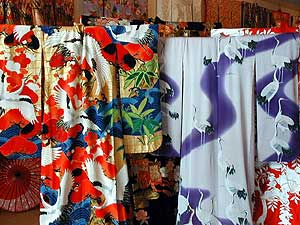|
Audio
Photos
Your Voice
|
Wabasha: the new kimono capital
March 12, 2004
Richard Fuller owns the world's largest collection of Japanese wedding kimonos. There are some 2,000 in all. It's not in Tokyo or even Kyoto, the center of kimono industry, but Wabasha, Minnesota. Recently, Fuller opened up a storefront gallery in downtown Wabasha to showcase the brightly colored robes. Already, it's made the sleepy river town a destination for quilters, crafts people, and visitors from Japan.
Wabasha, Minn. — There's an urgency to Richard Fuller's kimono collecting. For the past year and half Fuller's dominated the market buying intricately painted, woven and embroidered silk kimonos. He says he's trying to preserve what's quickly becoming a lost art.
"The weavers are dying off. The apprentices are no longer going into it. The distributors and the wholesalers are going. The department stores that sold them are going," Fuller explains. "You have an entire manufacturing distribution chain culminating with who's going to buy them disappearing."
That's because demand for the kimono has tapered. Record numbers of Japanese brides now prefer western wedding gowns to the traditional kimono. As a result many of the great kimono houses are on the verge of collapse.
 | |||
Richard Fuller's love for Japan began during a tour of duty with the U.S. Marine Corps in the late 1950s and 60s. He still wears his hair in the classic marine flat top. A long time Chicago resident, Fuller retired to his wife's hometown of Wabasha. He began his kimono project about 18 months ago.
Virtually all of Fuller's kimonos come from an special area in Kyoto where generations of artisans have earned their living producing the expensive garment. Each kimono begins a single strip of white Japanese silk. It takes months, sometimes even years, and as many as 50 people to transform the silk into the finished garment.
"I'm always amazed by the engineering process," says Fuller.
 | |||
Each kimono is a testament to the needle skills of the people who made it. Fuller points to seam where a long flowing arm joins the body. The embroidered patterns match up perfectly.
"You're looking at a flower with four or five different threads with gold on it and the sleeve where it connects to the body," says Fuller. "As you go over the crane fits and you go over to the next panel and there's a flower and gold leaf. Everything flows. There's no staggering."
Fuller's kimonos were produced during the flush years of the 1970s and 80s. It was a time when the average Japanese wedding cost close to $100,000, roughly four times the cost of most American weddings today.
"These kimonos cost anywhere from $8,000 to $60,000. Brides rent them for $2,000 to $8,000 for one day for three hours," he explains.
Fuller selects a red kimono, and takes it outside. He says the vibrant colors only truly come alive in natural light.
"Look at the birds. Look at all of that. This probably cost $10,000 to $16,000 new. We sell it for a thousand. It's a steal. You're not going to see artwork like this again," says Fuller.
Fuller's gallery Wind Whisper West is filled with similarly beautiful garments. Most are for sale for a fraction of their initial price. The former marine says he hopes the store will bridge the divide between East and West, while preserving what he believes a rich but vulnerable tradition.
|
News Headlines
|
Related Subjects
|

